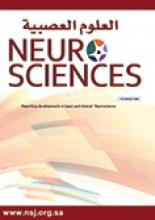Research ArticleOriginal Article
Open Access
Role of environmental factors in autism spectrum disorders in Saudi children aged 3-10 years in the Northern and Eastern regions of Saudi Arabia
Anitha Oommen, Reem S. AlOmar, Abdelaziz A. Osman and Halah E. Aljofi
Neurosciences Journal October 2018, 23 (4) 286-291; DOI: https://doi.org/10.17712/nsj.2018.4.20180170
Anitha Oommen
From the Department of Anatomy (Oommen), Faculty of Medicine, Northern Border University, and from the Department of Psychiatry (Osman), Al Amal Mental Health Complex, Arar, from the Department of Family and Community Medicine (AlOmar), College of Medicine, Department of Environmental Health (Aljofi), Institute for Research & Medical Consultations, Imam Abdulrahman Bin Faisal University, Dammam, Kingdom of Saudi Arabia, and from the Department of Community Psychiatry (Osman), Al Amal Hospital for Mental Health, Dubai, United Arab Emirates
MBBS, MDReem S. AlOmar
From the Department of Anatomy (Oommen), Faculty of Medicine, Northern Border University, and from the Department of Psychiatry (Osman), Al Amal Mental Health Complex, Arar, from the Department of Family and Community Medicine (AlOmar), College of Medicine, Department of Environmental Health (Aljofi), Institute for Research & Medical Consultations, Imam Abdulrahman Bin Faisal University, Dammam, Kingdom of Saudi Arabia, and from the Department of Community Psychiatry (Osman), Al Amal Hospital for Mental Health, Dubai, United Arab Emirates
MSc, PhDAbdelaziz A. Osman
From the Department of Anatomy (Oommen), Faculty of Medicine, Northern Border University, and from the Department of Psychiatry (Osman), Al Amal Mental Health Complex, Arar, from the Department of Family and Community Medicine (AlOmar), College of Medicine, Department of Environmental Health (Aljofi), Institute for Research & Medical Consultations, Imam Abdulrahman Bin Faisal University, Dammam, Kingdom of Saudi Arabia, and from the Department of Community Psychiatry (Osman), Al Amal Hospital for Mental Health, Dubai, United Arab Emirates
MBBS, MDHalah E. Aljofi
From the Department of Anatomy (Oommen), Faculty of Medicine, Northern Border University, and from the Department of Psychiatry (Osman), Al Amal Mental Health Complex, Arar, from the Department of Family and Community Medicine (AlOmar), College of Medicine, Department of Environmental Health (Aljofi), Institute for Research & Medical Consultations, Imam Abdulrahman Bin Faisal University, Dammam, Kingdom of Saudi Arabia, and from the Department of Community Psychiatry (Osman), Al Amal Hospital for Mental Health, Dubai, United Arab Emirates
MSc
References
- ↵
- Elwardany S,
- Ibrahim H,
- Askar G,
- Bayomi S
- ↵
- May T,
- Sciberras E,
- Brignell A,
- Williams K
- ↵
- Hansen SN,
- Schendel DE,
- Parner ET
- ↵
- Taylor B,
- Jick H,
- Maclaughlin D
- ↵
- Al Zahrani A
- ↵
- Dufault R,
- Schnoll R,
- Lukiw WJ,
- LeBlanc B,
- Cornett C,
- Patrick L,
- et al.
- ↵
- Patrick RP,
- Ames BN
- ↵
- Schmidt RJ,
- Tancredi DJ,
- Krakowiak P,
- Hansen RL,
- Ozonoff S
- ↵
- Mamidala MP,
- Kalikiri MK,
- Praveen Kumar PT,
- Rajesh N,
- Vallamkonda OR,
- Rajesh V
- Wu S,
- Wu F,
- Ding Y,
- Hou J,
- Bi J,
- Zhang Z
- ↵
- Lyall K,
- Schmidt RJ,
- Hertz-Picciotto I
- ↵
- Taylor LE,
- Swerdfeger AL,
- Eslick GD
- ↵
- Sharma A,
- Gokulchandran N,
- Sane H,
- Nagrajan A,
- Paranjape A,
- Kulkarni P,
- et al.
- ↵
- Taha GRA,
- Hussien H,
- Autism Spectrum Disorders in Developing Countries:Lessons from the Arab World
- ↵
- Zeina R,
- Al Ayadhi L M,
- Bashir S
- ↵
- Salhia HO,
- Al-Nasser LA,
- Taher LS,
- Al-Khathaami AM,
- El-Metwally AA
- ↵
- Maenner MJ,
- Rice CE,
- Arneson CL,
- Cunniff C,
- Schieve LA,
- Carpenter LA,
- et al.
- ↵
- Hussein H,
- Taha GRA
- ↵
- Al Sulaimani AA,
- Helmy FF,
- Abdel Wahab MM
- ↵
- Mahajnah M,
- Sharkia R,
- Shalabe H,
- Terkel-Dawer R,
- Akawi A,
- Zelnik N
- ↵
- Delobel-Ayoub M,
- Ehlinger V,
- Klapouszczak D,
- Maffre T,
- Raynaud JP,
- Delpierre C,
- et al.
- ↵
- Karimi P,
- Kamali E,
- Mousavi SM,
- Karahmadi M
- ↵
- Al Shaikh AM,
- Abaalkhail B,
- Soliman A,
- Kaddam I,
- Aseri K,
- Al Saleh Y,
- et al.
- ↵
- Bener A,
- Khattab AO,
- Al-Dabbagh MM
- ↵
- Magnusson C,
- Lundberg M,
- Lee BK,
- Rai D,
- Karlsson H,
- Gardner R,
- et al.
- ↵
- Idring S,
- Magnusson C,
- Lundberg M,
- Ek M,
- Rai D,
- Svensson AC,
- et al.
In this issue
Role of environmental factors in autism spectrum disorders in Saudi children aged 3-10 years in the Northern and Eastern regions of Saudi Arabia
Anitha Oommen, Reem S. AlOmar, Abdelaziz A. Osman, Halah E. Aljofi
Neurosciences Journal Oct 2018, 23 (4) 286-291; DOI: 10.17712/nsj.2018.4.20180170
Jump to section
Related Articles
- No related articles found.
Cited By...
- No citing articles found.





